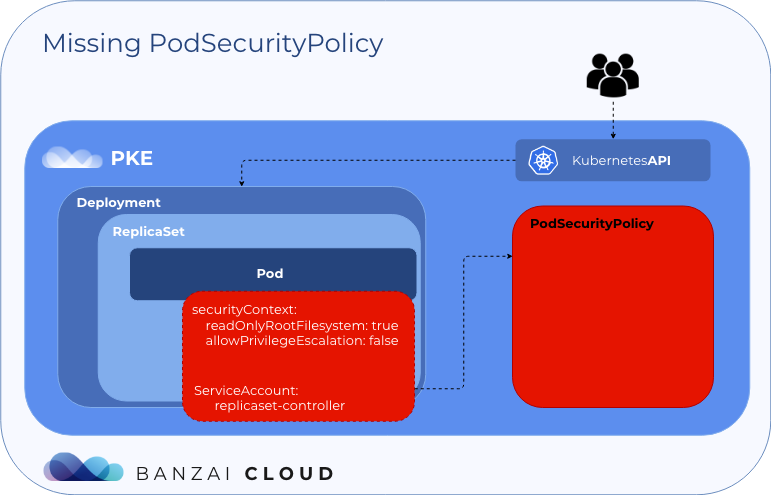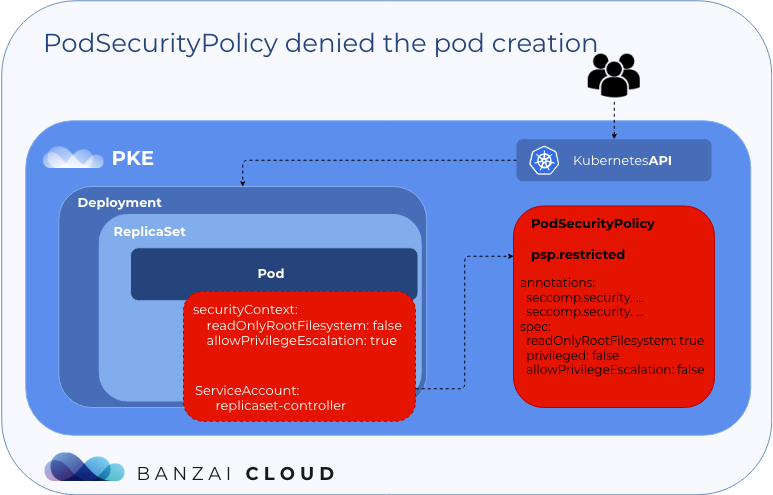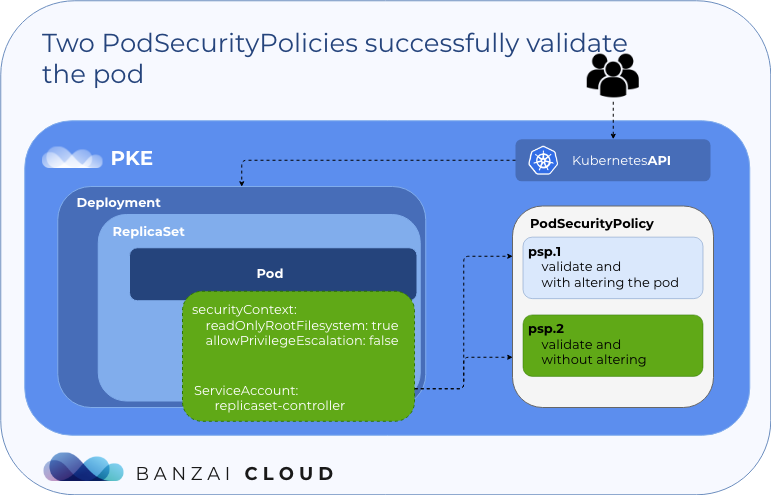A strong focus on security has always been a key part of the Banzai Cloud’s Pipeline platform. We incorporated security into our architecture early in the design process, and developed a number of supporting components to be used easily and natively on Kubernetes. From secrets, certificates generated and stored in Vault, secrets dynamically injected in pods, through provider agnostic authentication and authorization using Dex, to container vulnerability scans and lots more: the Pipeline platform handles all these as a default tier-zero feature.
As we open sourced and certified our own Kubernetes distribution, PKE - Pipeline Kubernetes Engine - we followed the same security principles we did with the Pipeline platform itself, and battle tested PKE with the CIS Kubernetes benchmark.
Pod Security Policies are a vital but often overlooked piece of the security jigsaw; they are key building blocks of PKE and the Pipeline platform. This post will help to demystify PSP by taking a deep dive into real examples.
Note that pod security policies are likely to be specific to an organization’s or application’s requirements, so there’s no one-size-fits-all approach. Pipeline enforces different sets of policies, however they can always be changed or disregarded.
What is Pod Security Policy? 🔗︎
Pod Security Policies are cluster-wide resources that control security sensitive aspects of pod specification. PSP objects define a set of conditions that a pod must run with in order to be accepted into the system, as well as defaults for their related fields. PodSecurityPolicy is an optional admission controller that is enabled by default through the API, thus policies can be deployed without the PSP admission plugin enabled. This functions as a validating and mutating controller simultaneously.
Pod Security Policies allow you to control:
- The running of privileged containers
- Usage of host namespaces
- Usage of host networking and ports
- Usage of volume types
- Usage of the host filesystem
- A white list of Flexvolume drivers
- The allocation of an FSGroup that owns the pod’s volumes
- Requirments for use of a read only root file system
- The user and group IDs of the container
- Escalations of root privileges
- Linux capabilities, SELinux context, AppArmor, seccomp, sysctl profile
If you’re interested in more details, check out the official Kubernetes documentation
PSP examples using PKE 🔗︎
Our own managed Kubernetes version, Banzai Cloud PKE, supports PSP, and it’s what we’ll be using in the following examples. Note that PKE is certified and 100% API compatible with upstream Kubernetes and other certified K8s providers, so, in the upcoming PSP examples feel free to use whichever Kubernetes distribution you prefer.
In order to use (and understand) Pod Security Policies, we need a k8s cluster with an enabled PodSecurityPolicy admission controller. If you prefer a cloud environment you can use the Pipeline platform to spin up a Kubernetes cluster on one of our 5 supported cloud providers or on prem (VMware or bare metal).
For simplicity’s sake, let’s use PKE, but in a local Vagrant development environment.
0. Install PKE in Vagrant 🔗︎
If you already have vagrant and virtualbox installed, you can skip to the next section. Note, you will still need to launch a node though.
brew cask install virtualbox
brew cask install vagrant
vagrant plugin install vagrant-vbguest
git clone git@github.com:banzaicloud/pke.git
cd pke
vagrant up node1To install PKE to a vagrant machine:
vagrant ssh node1
sudo -s
curl -v https://banzaicloud.com/downloads/pke/pke-0.2.3 -o /usr/local/bin/pke
chmod +x /usr/local/bin/pke
export PATH=$PATH:/usr/local/bin/
pke install single --with-plugin-psp
mkdir -p $HOME/.kube
cp -i /etc/kubernetes/admin.conf $HOME/.kube/config
chown $(id -u):$(id -g) $HOME/.kube/configNow let’s check and see if the PSP admission-controller is enabled
grep -- --enable-admission-plugins /etc/kubernetes/manifests/kube-apiserver.yaml
- --enable-admission-plugins=AlwaysPullImages,DenyEscalatingExec,EventRateLimit,NodeRestriction,ServiceAccount,PodSecurityPolicyWe’re all set. Now let’s take a deep dive into some examples.
1. Example of a restricted PodSecurityPolicy used cluster-wide 🔗︎
First, let’s create an example deployment as seen below. In this manifest there are also a few securityContexts defined at the pod and container level.
runAsUser: 1000means all containers in the pod will run as user UID 1000fsGroup: 2000means the owner for mounted volumes and any files created in that volume will be GID 2000allowPrivilegeEscalation: falsemeans the container cannot escalate privilegesreadOnlyRootFilesystem: truemeans the container can only read the root filesystem
example-restricted-deployment.yaml:
1apiVersion: apps/v1
2kind: Deployment
3metadata:
4 name: alpine-restricted
5 labels:
6 app: alpine-restricted
7spec:
8 replicas: 1
9 selector:
10 matchLabels:
11 app: alpine-restricted
12 template:
13 metadata:
14 labels:
15 app: alpine-restricted
16 spec:
17 securityContext:
18 runAsUser: 1000
19 fsGroup: 2000
20 volumes:
21 - name: sec-ctx-vol
22 emptyDir: {}
23 containers:
24 - name: alpine-restricted
25 image: alpine:3.9
26 command: ["sleep", "3600"]
27 volumeMounts:
28 - name: sec-ctx-vol
29 mountPath: /data/demo
30 securityContext:
31 allowPrivilegeEscalation: false
32 readOnlyRootFilesystem: trueIf we deploy this example now, it will fail.
kubectl apply -f example-deployment.yaml
kubectl get deploy,rs,pod
# output
NAME READY UP-TO-DATE AVAILABLE AGE
deployment.extensions/alpine-test 0/1 0 0 67s
NAME DESIRED CURRENT READY AGE
replicaset.extensions/alpine-test-85c976cdd 1 0 0 67sAs we can see the pod is missing. What happened?
kubectl describe replicaset.extensions/alpine-test-85c976cdd | tail -n3
# output
Type Reason Age From Message
---- ------ ---- ---- -------
Warning FailedCreate 114s (x16 over 4m38s) replicaset-controller Error creating: pods "alpine-test-85c976cdd-" is forbidden: unable to validate against any pod security policy: []
Without Pod Security Policies, the replicaset controller cannot create the pod. Let’s deploy a restricted PSP and create a ClusterRole and ClusterRolebinding, which will allow the replicaset-controller to use the PSP defined above.
kubectl apply -f psp-restricted.yamlpsp-restricted.yaml:
1apiVersion: policy/v1beta1
2kind: PodSecurityPolicy
3metadata:
4 name: psp.restricted
5 annotations:
6 seccomp.security.alpha.kubernetes.io/defaultProfileName: 'docker/default'
7 seccomp.security.alpha.kubernetes.io/allowedProfileNames: 'docker/default'
8spec:
9 readOnlyRootFilesystem: true
10 privileged: false
11 allowPrivilegeEscalation: false
12 runAsUser:
13 rule: 'MustRunAsNonRoot'
14 supplementalGroups:
15 rule: 'MustRunAs'
16 ranges:
17 - min: 1
18 max: 65535
19 fsGroup:
20 rule: 'MustRunAs'
21 ranges:
22 - min: 1
23 max: 65535
24 seLinux:
25 rule: 'RunAsAny'
26 volumes:
27 - configMap
28 - emptyDir
29 - secret
30---
31apiVersion: rbac.authorization.k8s.io/v1
32kind: ClusterRole
33metadata:
34 name: psp:restricted
35rules:
36- apiGroups:
37 - policy
38 resourceNames:
39 - psp.restricted
40 resources:
41 - podsecuritypolicies
42 verbs:
43 - use
44---
45apiVersion: rbac.authorization.k8s.io/v1
46kind: ClusterRoleBinding
47metadata:
48 name: psp:restricted:binding
49roleRef:
50 apiGroup: rbac.authorization.k8s.io
51 kind: ClusterRole
52 name: psp:restricted
53subjects:
54 - kind: ServiceAccount
55 name: replicaset-controller
56 namespace: kube-systemIn psp-restricted.yaml there are some restrictions for pods with the psp.restricted policy:
- the root filesystem must be readonly
- it doesn’t allow for privileged containers
- privilege escalations are forbidden
readOnlyRootFilesystem: true - the user must be nonroot
runAsUser: rule: 'MustRunAsNonRoot' - fsGroup and supplementalGroups cannot be root
defined allowed range - the pod can only use the volumes specified:
configMap,emptyDirandsecret - in the annotations section there is a
seccompprofile, which is used by containers. Due to these annotations, the PSP will mutate the podspec before deploying it. If we check the pod manifest in Kubernetes, we will seeseccompannotations defined there as well.
In psp:restricted ClusterRole and psp:restricted:binding ClusterRoleBinding allows us to use the psp.restricted policy for the replicaset-controller service account.
Now, let’s delete the example-deployment and apply it again:
kubectl delete -f example-deployment.yaml
kubectl apply -f example-deployment.yaml
kubectl get pod,deploy,rs
# output
NAME READY STATUS RESTARTS AGE
pod/alpine-test-85c976cdd-k69cn 1/1 Running 0 24s
NAME READY UP-TO-DATE AVAILABLE AGE
deployment.extensions/alpine-test 1/1 1 1 24s
NAME DESIRED CURRENT READY AGE
replicaset.extensions/alpine-test-85c976cdd 1 1 1 24s
OK, let’s take a look at the pod's annotations:
kubectl get pod/alpine-test-85c976cdd-k69cn -o jsonpath='{.metadata.annotations}'
# output
map[kubernetes.io/psp:psp.restricted seccomp.security.alpha.kubernetes.io/pod:docker/default]We can see that there are two annotations set:
- kubernetes.io/psp:psp.restricted
- seccomp.security.alpha.kubernetes.io/pod:docker/default
The first is the PodSecurityPolicy used by the pod. The second is the seccomp profile used by the pod. Seccomp (secure computing mode) is a Linux kernel feature used to restrict the actions available inside a container.
Does it really work?
You can check it in host via the status of the sleep 3600 process run by our alpine pod:
ps ax | grep "sleep 3600"
grep Seccomp /proc/<pid of sleep 3600>/status
# output
Seccomp: 2The /proc filesystem gives some informations:
- 0 means SECCOMP_MODE_DISABLED
- 1 means SECCOMP_MODE_STRICT
- 2 means SECCOMP_MODE_FILTER
2. Create a privileged PodSecurityPolicy and use it with a specified service account 🔗︎
example-privileged-deployment.yaml:
1apiVersion: apps/v1
2kind: Deployment
3metadata:
4 name: alpine-privileged
5 namespace: privileged
6 labels:
7 app: alpine-privileged
8spec:
9 replicas: 1
10 selector:
11 matchLabels:
12 app: alpine-privileged
13 template:
14 metadata:
15 labels:
16 app: alpine-privileged
17 spec:
18 securityContext:
19 runAsUser: 1000
20 fsGroup: 2000
21 volumes:
22 - name: sec-ctx-vol
23 emptyDir: {}
24 containers:
25 - name: alpine-privileged
26 image: alpine:3.9
27 command: ["sleep", "1800"]
28 volumeMounts:
29 - name: sec-ctx-vol
30 mountPath: /data/demo
31 securityContext:
32 allowPrivilegeEscalation: true
33 readOnlyRootFilesystem: falseAt this juncture we want to start a pod with write permissions on the root filesystem, and to enable privilege escalation.
kubectl create ns privileged
kubectl apply -f example-privileged-deployment.yaml
kubectl get pod,deploy,rs -n privileged
# output
NAME READY UP-TO-DATE AVAILABLE AGE
deployment.extensions/alpine-privileged 0/1 0 0 4m
NAME DESIRED CURRENT READY AGE
replicaset.extensions/alpine-privileged-7bdb64b569 1 0 0 4mAs you can see, the pod is missing. Let’s check the replicaset events:
kubectl describe replicaset.extensions/alpine-privileged-7bdb64b569 -n privileged | tail -n3
# output
Type Reason Age From Message
---- ------ ---- ---- -------
Warning FailedCreate 29s (x17 over 5m56s) replicaset-controller Error creating: pods "alpine-privileged-7bdb64b569-" is forbidden: unable to validate against any pod security policy: [spec.containers[0].securityContext.readOnlyRootFilesystem: Invalid value: false: ReadOnlyRootFilesystem must be set to true spec.containers[0].securityContext.allowPrivilegeEscalation: Invalid value: true: Allowing privilege escalation for containers is not allowed]The pod is created with the replicaset-controller service account, which allows use of the psp.restricted policy. Pod creation failed because podspec contains the allowPrivilegeEscalation: true and readOnlyRootFilesystem: false securityContexts - at this time, these are invalid values as far as psp.restricted is concerned.

So let’s create a new PSP, which will allow us to use the serviceaccount we want.
First, we create a new service account in the privileged namespace:
kubectl create sa privileged-sa -n privilegedAfter that, let’s modify the example-privileged-deployment.yaml: manifest file, adding the service account for the pod:
12...
13 template:
14 metadata:
15 labels:
16 app: alpine-privileged
17 spec:
18 serviceAccountName: privileged-sa
19 securityContext:
20 runAsUser: 1
21 fsGroup: 1
22...Finally, we’ll deploy a psp.privileged policy and create a Role and a Rolebinding to allow the privileged-sa to use the defined PSP.
kubectl apply -f psp-restricted.yamlpsp-privileged.yaml:
1apiVersion: policy/v1beta1
2kind: PodSecurityPolicy
3metadata:
4 creationTimestamp: null
5 name: psp.privileged
6spec:
7 readOnlyRootFilesystem: false
8 privileged: true
9 allowPrivilegeEscalation: true
10 runAsUser:
11 rule: 'RunAsAny'
12 supplementalGroups:
13 rule: 'RunAsAny'
14 fsGroup:
15 rule: 'RunAsAny'
16 seLinux:
17 rule: 'RunAsAny'
18 volumes:
19 - configMap
20 - emptyDir
21 - secret
22---
23apiVersion: rbac.authorization.k8s.io/v1
24kind: Role
25metadata:
26 name: psp:privileged
27 namespace: privileged
28rules:
29- apiGroups:
30 - policy
31 resourceNames:
32 - psp.privileged
33 resources:
34 - podsecuritypolicies
35 verbs:
36 - use
37---
38apiVersion: rbac.authorization.k8s.io/v1
39kind: RoleBinding
40metadata:
41 name: psp:privileged:binding
42 namespace: privileged
43roleRef:
44 apiGroup: rbac.authorization.k8s.io
45 kind: Role
46 name: psp:privileged
47subjects:
48 - kind: ServiceAccount
49 name: privileged-sa
50 namespace: privilegedThe psp.privileged policy contains readOnlyRootFilesystem: false and allowPrivilegeEscalation: true. The privileged-sa service account in the privileged namespace allows us to use the psp.privileged policy, so, if we deploy the modified example-privileged-deployment.yaml, the pod should start.
Now let’s apply it again example-privileged-deployment.yaml and check the deployment:
kubectl delete -f example-privileged-deployment.yaml
kubectl apply -f example-privileged-deployment.yaml
kubectl get po,deploy,rs -n privileged
# output
NAME READY STATUS RESTARTS AGE
pod/alpine-privileged-667dc5c859-q7mf6 1/1 Running 0 23s
NAME READY UP-TO-DATE AVAILABLE AGE
deployment.extensions/alpine-privileged 1/1 1 1 23s
NAME DESIRED CURRENT READY AGE
replicaset.extensions/alpine-privileged-667dc5c859 1 1 1 23s
The service account is now defined for the replicaset, and the pod can use the psp.privileged policy:
kubectl get rs alpine-privileged-667dc5c859 -n privileged -o jsonpath='{.spec.template.spec.serviceAccount}'
# output
privileged-saCheck pod annotations:
kubectl get pod/alpine-privileged-667dc5c859-q7mf6 -n privileged -o jsonpath='{.metadata.annotations}'
# output
map[kubernetes.io/psp:psp.privileged]What about seccomp? In the psp.privileged policy no seccomp profile is defined. Let’s take a look. What we’re looking for is sleep 1800:
ps ax | grep "sleep 1800"
grep Seccomp /proc/<pid of sleep 1800>/status
# output
Seccomp: 03. Create multiple PodSecurityPolicies and check the policy order 🔗︎
When multiple policies are available, the pod security policy controller selects policies in the following order:
- If policies successfully validate the pod without altering it, they are used.
- In the event of a pod creation request, the first valid policy in alphabetical order is used.
- Otherwise, if there’s a pod update request an error is returned, because pod mutations are disallowed during update operations.
Let’s dive in!
First, we’ll create two Pod Security Policies with RBAC:
psp-multiple.yaml:
1apiVersion: policy/v1beta1
2kind: PodSecurityPolicy
3metadata:
4 name: psp.1
5 annotations:
6 seccomp.security.alpha.kubernetes.io/defaultProfileName: 'docker/default'
7 seccomp.security.alpha.kubernetes.io/allowedProfileNames: 'docker/default'
8spec:
9 readOnlyRootFilesystem: false
10 privileged: false
11 allowPrivilegeEscalation: true
12 runAsUser:
13 rule: 'RunAsAny'
14 supplementalGroups:
15 rule: 'RunAsAny'
16 fsGroup:
17 rule: 'RunAsAny'
18 seLinux:
19 rule: 'RunAsAny'
20 volumes:
21 - configMap
22 - emptyDir
23 - secret
24---
25apiVersion: policy/v1beta1
26kind: PodSecurityPolicy
27metadata:
28 name: psp.2
29 annotations:
30 seccomp.security.alpha.kubernetes.io/defaultProfileName: 'docker/default'
31 seccomp.security.alpha.kubernetes.io/allowedProfileNames: 'docker/default'
32spec:
33 readOnlyRootFilesystem: false
34 privileged: false
35 allowPrivilegeEscalation: false
36 runAsUser:
37 rule: 'MustRunAsNonRoot'
38 supplementalGroups:
39 rule: 'RunAsAny'
40 fsGroup:
41 rule: 'RunAsAny'
42 seLinux:
43 rule: 'RunAsAny'
44 volumes:
45 - configMap
46 - emptyDir
47 - secret
48---
49apiVersion: rbac.authorization.k8s.io/v1
50kind: Role
51metadata:
52 name: psp:multy
53 namespace: multy
54rules:
55- apiGroups:
56 - policy
57 resourceNames:
58 - psp.1
59 - psp.2
60 resources:
61 - podsecuritypolicies
62 verbs:
63 - use
64---
65apiVersion: rbac.authorization.k8s.io/v1
66kind: RoleBinding
67metadata:
68 name: psp:multy:binding
69 namespace: multy
70roleRef:
71 apiGroup: rbac.authorization.k8s.io
72 kind: Role
73 name: psp:multy
74subjects:
75 - kind: ServiceAccount
76 name: replicaset-controller
77 namespace: kube-systemAs you can see below, there are two PSPs in psp-multiple.yaml, which are almost identical. Now, Role and RoleBinding in the multy namespace will allow us to use a predefined psp.1 and psp.2 for the replicaset-controller.
Let’s deploy it:
kubectl create ns multy
kubectl apply -f psp-multiple.yaml
kubectl get psp
# output
NAME PRIV CAPS SELINUX RUNASUSER FSGROUP SUPGROUP READONLYROOTFS VOLUMES
...
psp.1 false RunAsAny RunAsAny RunAsAny RunAsAny true configMap,emptyDir,secret
psp.2 false RunAsAny MustRunAsNonRoot RunAsAny RunAsAny true configMap,emptyDir,secret
...
psp.restricted false RunAsAny MustRunAsNonRoot MustRunAs MustRunAs true configMap,emptyDir,secret
...This list contains only those policies which are allowed to be used by the replicaset-controller service account.
Now let’s create a sample deployment:
example-multy-psp-deployment.yaml:
1apiVersion: apps/v1
2kind: Deployment
3metadata:
4 name: alpine-multy
5 namespace: multy
6 labels:
7 app: alpine-multy
8spec:
9 replicas: 1
10 selector:
11 matchLabels:
12 app: alpine-multy
13 template:
14 metadata:
15 labels:
16 app: alpine-multy
17 spec:
18 securityContext:
19 runAsUser: 1000
20 fsGroup: 2000
21 containers:
22 - name: alpine-multy
23 image: alpine:3.9
24 command: ["sleep", "2400"]
25 securityContext:
26 allowPrivilegeEscalation: false
27 readOnlyRootFilesystem: falsekubectl apply -f example-multy-psp-deployment.yaml
kubectl get po -n multy
# output
NAME READY STATUS RESTARTS AGE
alpine-multy-5864df9bc8-mgg68 1/1 Running 0 20sCheck used PSP:
kubectl get pod alpine-multy-5864df9bc8-mgg68 -n multy -o jsonpath='{.metadata.annotations}'
# output
map[kubernetes.io/psp:psp.1 seccomp.security.alpha.kubernetes.io/pod:docker/default]As you can see, this pod uses the psp.1 PodSecurityPolicy, which is the first valid policy in alphabetical order, though it is the second rule in the PSP selection.

Let’s modify psp.2 by deleting seccomp's annotations:
1apiVersion: policy/v1beta1
2kind: PodSecurityPolicy
3metadata:
4 name: psp.2
5spec:
6 readOnlyRootFilesystem: falsekubectl apply -f psp-multy.yaml
kubectl delete -f example-multy-psp-deployment.yaml
kubectl apply -f example-multy-psp-deployment.yaml
kubectl get po -n multy
# output
NAME READY STATUS RESTARTS AGE
alpine-multy-5864df9bc8-lj2fz 1/1 Running 0 29sCheck the used PSP:
kubectl get pod alpine-multy-5864df9bc8-lj2fz -n multy -o jsonpath='{.metadata.annotations}'
# output
map[kubernetes.io/psp:psp.2]Now, the pod uses psp.2 due to the annotations being deleted, since, in this case, the policy successfully validated the pod without altering it; it’s the 1st rule in PSP selection.

Conclusion 🔗︎
As these three examples demonstrate, PSP enables admins to apply fine grain control over pods and containers running in Kubernetes, either by granting or denying access to specific resources. These policies are relatively easy to create and deploy, and should be useful components of any Kubernetes security strategy.
About Banzai Cloud Pipeline 🔗︎
Banzai Cloud’s Pipeline provides a platform for enterprises to develop, deploy, and scale container-based applications. It leverages best-of-breed cloud components, such as Kubernetes, to create a highly productive, yet flexible environment for developers and operations teams alike. Strong security measures — multiple authentication backends, fine-grained authorization, dynamic secret management, automated secure communications between components using TLS, vulnerability scans, static code analysis, CI/CD, and so on — are default features of the Pipeline platform.
















